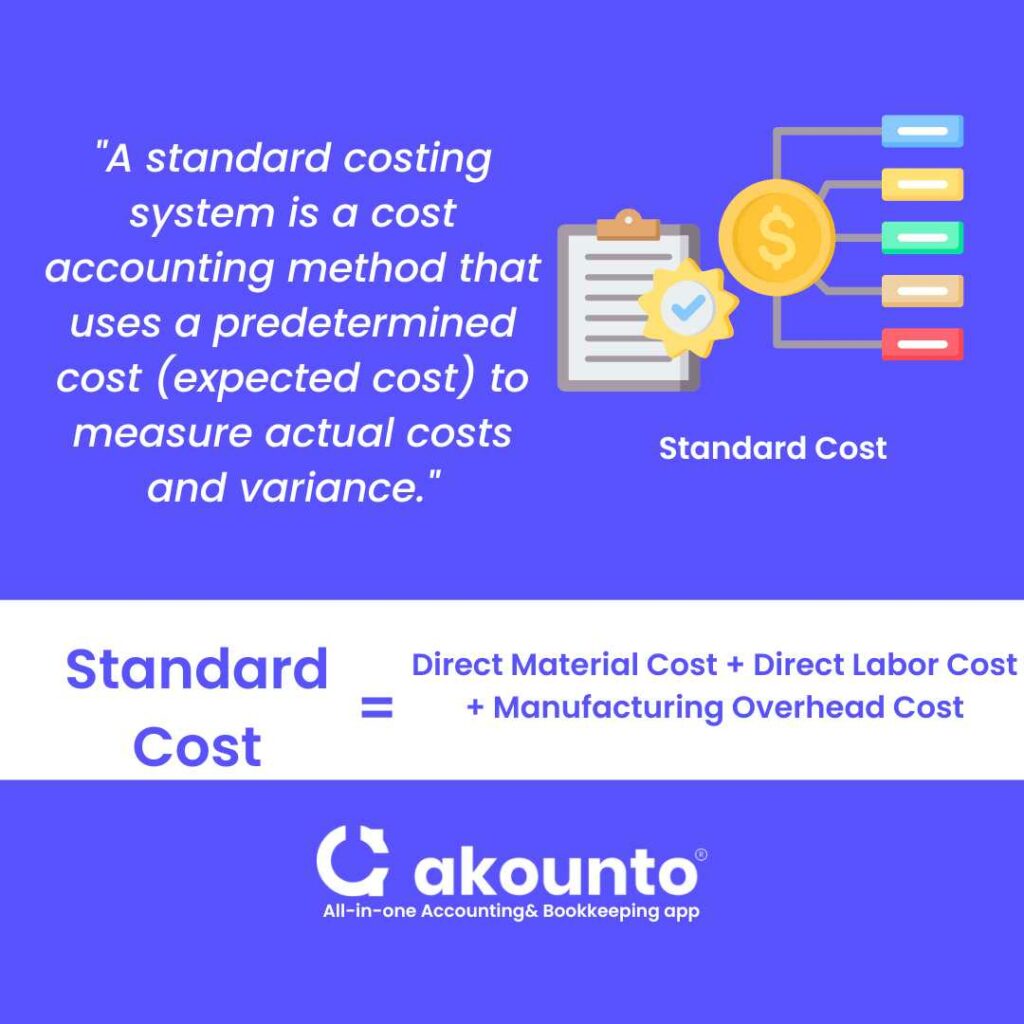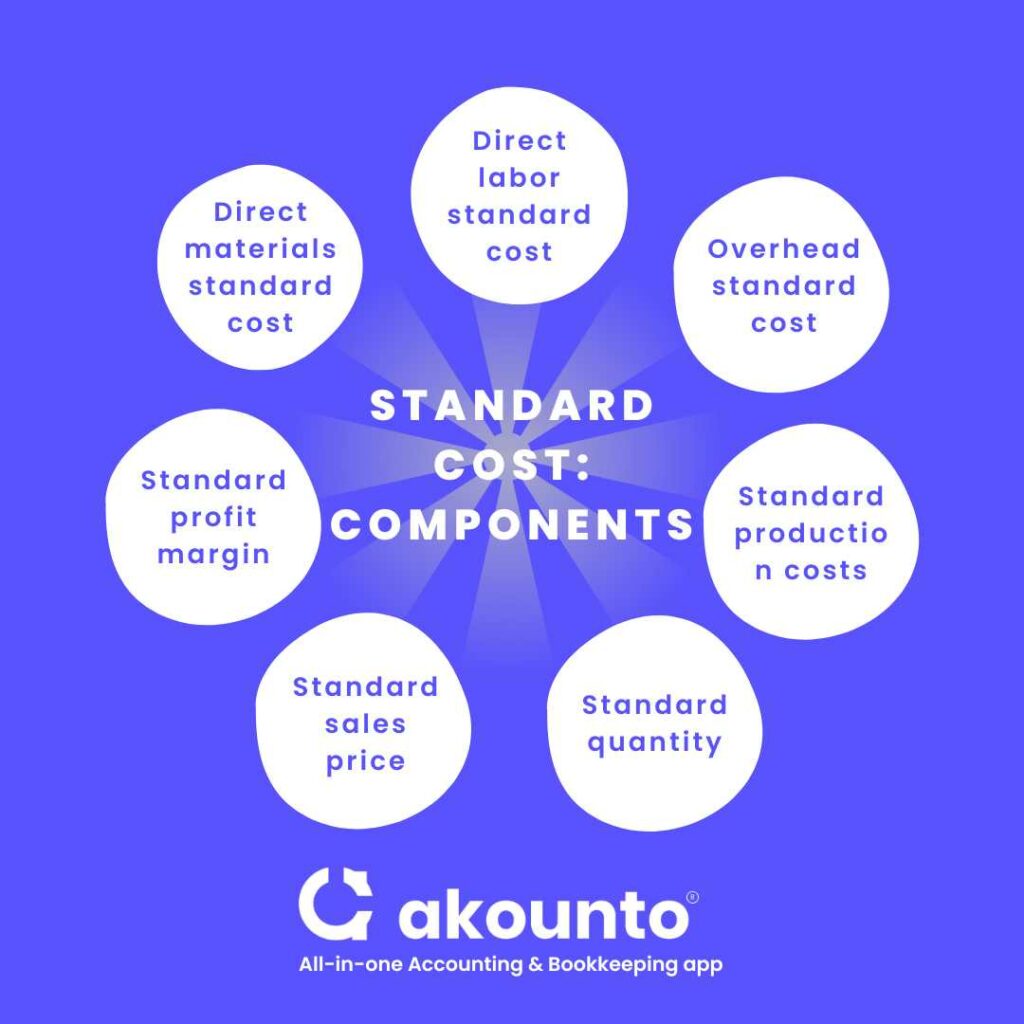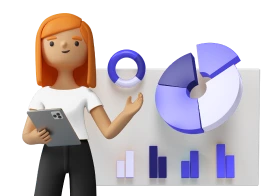What is Standard Costing?
A standard costing system is a cost accounting method that uses a predetermined cost to measure actual costs and variance.
The main objective of a standard cost system is to provide a basis of comparison between a company’s expected and actual costs, which highlights gaps in planning and execution, helping managers to take identify inefficiencies and do course corrections.

In a manufacturing process, there are many variables due to which managers cannot predict the company’s actual costs in a production process. Standard cost, or “pre-set costs,” gives the basis for budgeting and reduces unpredictability to some extent.
The difference between expected and actual costs is called variance cost.
Why do Companies use Standard Costs?
A production process is complex, and an accurate prediction of the expected cost is impossible. The company uses standard cost to establish benchmarks for performance, cost allocation, budgeting, deciding sales price, and decision-making.
Cost control helps management achieve greater profitability and improve budgeting and forecasting accuracy.
The ultimate aim of standard costing is to empower organizations to refine, optimize and efficiently run their production process and bring actual cost near to the standard cost, thereby improving cost control.
When there is a difference between the company’s actual costs and standard costs, it becomes an opportunity to remove the discrepancies by refining the production process, forecasting methods, and overall efficiency.
Components of Standard Costing

The components of “Standard Cost” or “Expected Cost” are as follows.
- Direct materials standard cost: Expected direct materials price that includes the cost of raw materials, freight, shipping and installation charges, etc., to produce a unit of output.
- Direct labor standard cost: The predetermined direct labor cost comprises direct labor standard hours and direct labor rate, including wages, salaries, benefits, and payroll taxes.
- Overhead standard cost: Expected overhead costs include indirect material cost, indirect labor cost, and other indirect costs like rent, taxes, utilities, etc., to manufacture one unit of output.
- Standard production costs: Projected costs include the standard cost of labor, material, and overhead in producing a single unit of output.
- Standard quantity: Expected quantity of inputs and raw material inventory value needed to produce a unit of output; it includes the number of working hours, calculating inventory quantities, etc.
- Standard sales price: Based on the competition, market demand, and strategy, the company’s management decides the selling price.
- Standard profit margin: Standard cost of production is subtracted from the standard selling price to calculate the standard profit margin.
Variance and Standard Cost
The actual cost will always be different from the projected standard cost. The cost accountant periodically calculates the differences, called variance, and updates the accounting records so that the chances of any significant accounting efficiencies are minimized.
When actual expenses are less than projected, it is a favorable variance. While in a reverse scenario, it will be an unfavorable variance.
Favorable variances signify that the company can predict, identify and control the costs effectively, while unfavorable variances highlight gaps in reading the business environment, leading to loss of profitability.
Advantages and Problems with Standard Costing
Advantages
There are several advantages of using standard costing in a business, including:
- Improved cost control: Standard costing system helps compare actual costs with expected costs by setting the benchmark or thresholds for actual costs.
- Better decision-making: Managers use standard costing method to have reliable and accurate data to spot and determine efficiencies when significant variances occur.
- Increased efficiency: With the help of the standard costing method, decision-makers can include all the variables that can be controlled internally and streamline business operations when actual amounts spent exceed standard costs.
- Aids in budgeting and forecasting: Standard costing technique helps to create accurate budgets and results in controlled costs by providing a reliable basis for estimating future costs and revenues.
- Tool for performance measurement: Standard costing helps in measuring actual spending costs with the projected amounts and helps to identify the areas for improvement and establish targets for future performance.
- Simplified cost accounts: Standard costing simplifies cost accounting as actual costs are measured against predetermined costs; thus, there is no need for complex and detailed recordkeeping, and the accounting process directly contributes to decision-making.
Standard Costing Disadvantages
Potential disadvantages of standard costing are:
- Time-consuming: Setting up standards for labor, supplies, and overhead can be time-consuming and require a lot of effort and resources.
- Possibility of wrong estimates: Standard costing works on the assumption that the actual price of labor, inventory, overheads, etc., will be utilized consistently and predictably, which may not always be the case in practical terms. Inaccurate cost estimates and variances may be the outcome of this.
- More standardization and less innovation: While employees seek to align actual performance with predicted costs resulting in lower production costs, new expenditures on innovation will be hampered as it will eventually lead to unfavorable variances.
- Not universally applicable: Standard pricing may not be applicable for all businesses, especially those with significant degrees of product customization or where production procedures are frequently altered.
- May lead to internal conflict: While performance measurement focuses on measuring actual costs with the predicted costs, it may lead to budget constraints, and in case the standards are perceived to be unfair or unrealistic, then could lead to production delays.
Steps to Calculate the Standard Cost
Formula to calculate the standard cost:
Standard Cost = Direct Material Cost + Direct Labor Cost + Manufacturing Overhead Cost
- Direct material cost includes the cost of raw materials needed to produce the product,
- Direct labor cost includes the cost of wages and benefits paid to workers involved in the production process, and
- Manufacturing overhead cost includes the indirect costs of production, such as utilities, rent, depreciation, and maintenance.
While calculating standard costs, the managers analyze the following:
- Historical data: Pertaining to past cost records as they represent the actual cost
- Cost components: material, labor, and overhead costs
- Business environment: Foreseeable future regarding inflation, raw material availability, technological changes, new manufacturing standards, etc.
- Inputs from company’s management: Company’s goals, production targets, budget allocation, etc.
The calculation of standard cost includes majorly three steps:
Step 1: Calculate standard costs per unit basis, adding material, labor, and overhead costs.
Step 2: Multiply all the per-unit cost calculations with the production target.
Step 3: Add other fixed costs provided promptly to get final standard costs for a manufacturing plant or product line.
Numerical Example
Peter J Smith is a production manager in Company A, which manufactures 3D printers. To ascertain production costs at the beginning of an accounting period, he considered the company’s production process, past trends, and anticipated market conditions in the future.
The following information is available:
- Company’s annual production target:
- Expected direct materials standard cost: $ 150 per unit
- Direct labor rate: $ 25 per hour
- Variable overhead standard cost: $20 per hour
- Fixed cost standard: $ 125,000
- Total hours per unit of printer: 12 hours per unit
Calculate the standard cost for this product line.
Solution
Standard Cost for a product line in manufacturing plant A
| Standard Cost for a product line in manufacturing plant A | |||
| Step 1: Calculating Standard Costs on Per Unit Basis | |||
| Types of standard costs (per unit) | Rate ($) | Hours | Total Cost ($) |
| Direct Material | 150 | 150 | |
| Direct Labor | 25 | 12 Hours | 300 |
| Variable Overhead | 20 | 12 Hours | 240 |
| Total Standard Cost Per Unit ($) | ($) 690 | ||
| Step2: Calculate total per unit costs with production target | |||
| Per Unit Cost | Production Target | Total | |
| Direct Material | 150 ($) | 6000 | 900,000 |
| Direct Labor | 300 ($) | 6000 | 1800000 |
| Variable Overhead | 240 ($) | 6000 | 1440000 |
| Total Standard Cost | 690 ($) | 6000 | ($) 4140000 |
| Step3: Add standard fixed cost | |||
| Total Standard Cost | ($) 125,000 | ||
| ($) 4140000 | |||
| Total Standard costs of manufacturing at a particular plant | ($) 42,65,000 |
How do Standard Costs Differ from Creating a Budget?
Standard cost and budget are both used as inputs for financial planning to manage cost and revenues, so they have some similarities but have important differences, as mentioned below:
- Standard costs are used as inputs to control material, overhead, and labor. While budgeting is a financial plan to manage overall operations than just manufacturing costs.
- Standard costs are used to measure performance, while budgets are used to plan and control operations.
- Standard costs are detailed at a unit level, while budgets cover entire organizations.
- The standard costing method uses historical data to predict costs, while the budget deals with resource allocation and uses revenues and expenses estimates.
Conclusion
Running a small business, a startup, or planning projects requires controlling costs, optimizing operations, and identifying gaps to address where actual cost differences lie concerning predetermined costs.
Standard costs act as a reference point for decision-making and controlling costs. The business environment is unpredictable, so standard costing helps in anticipating costs that reduce a company’s risk exposure.
Visit Akounto’s blog for knowledge and tips on running profitable, efficient, and cost-effective business operations.




